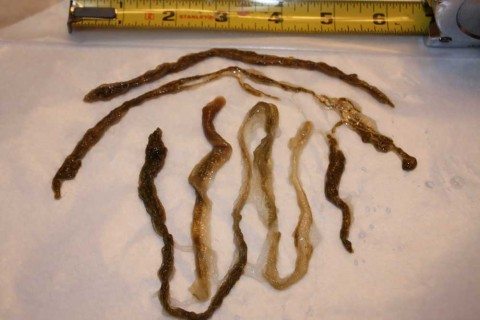
The larvae mature in the small intestine and move to muscle cells where they can live for months or years. People can get infected when they eat meat (particularly pork) that is undercooked. These larvae live in pigs and other wild carnivores, such as bears.
Trichinosis (trichiniasis): Trichinosis is an infection caused by the roundworm Trichinella spiralis. About half of the population of some African countries have been infected with threadworm. There they grow into adults and produce eggs. When the person coughs, the larvae are swallowed and move to the intestines. Inside the body, they move to the lymph nodes and then to the lungs and throat. Threadworm (strongyloidiasis): Threadworm usually happens when someone walks barefoot on contaminated soil, and larvae get into the skin. It affects about 20 million people, mostly in Africa. River blindness is spread by day-biting flies, and is the leading cause of blindness worldwide. River blindness (onchocerciasis): River blindness is an eye infection caused by the roundworm Onchocerca volvulus. Pinworm, which is often spread in day care centers, schools, and camps, affects as many as 1/3 of all American children. #Large hookworms in humans skin
The pregnant female worms move to the anus and deposit large numbers of eggs in the skin around that area. The eggs hatch in the small intestine, and adult worms live in the large intestine.
Pinworm (enterobiasis): A pinworm infection happens when a person consumes food or drink contaminated with feces. About 90 million people worldwide have been infected with these roundworms. They release eggs that circulate through the blood. Over 6 to 12 months, adult worms mature and live in human lymph vessels and nodes. Lymphatic filariasis: A lymphatic filariasis infection happens when a person is bitten by a mosquito containing the roundworms Wucheria bancrofti, Brugia malayi, or Brugia timori. About 3 to 13 million people in equatorial Africa have been infected with Loa loa. Like river blindness, loiasis is spread by day-biting flies. Loiasis: Loiasis is an infection caused by the roundworm Loa loa. 
These roundworms infect about 25% of the world's population. Children are especially vulnerable to this kind of infection. They feed off the blood of the infected person, which can cause anemia. There they latch on and grow into adults, laying more eggs. They go through the skin, making their way through the lungs to the small intestine.
Hookworm (ancylostomiasis): A hookworm infection happens when larvae come into contact with human skin, through contaminated soil or feces. This type of roundworm infects 10 to 40 million people annually worldwide, mostly in India, West and Central Africa, and some Middle Eastern countries. The tip of the worm comes out through the skin to lay its eggs whenever the skin is immersed in water. Then the adult moves to another area of the body (usually the legs) and comes out through a painful blister. Larvae grow into adults in the intestines, where they can be 3 feet long. Guinea worm disease (dracunculosis): People can become infected with Guinea worm disease when they drink contaminated water. They can produce eggs for a year or more. Once they swallowed, they go into the intestines and become adults. Once in the body, the larvae go into the lungs and then the throat, where they are coughed up and swallowed. That can happen when people eat food grown in soil that has been mixed with human waste. Ascariasis: People become infected when they eat food or drink water that contains the eggs of the roundworm Ascaris lumbricoides. 
Different species of roundworms cause different infections. Most roundworms or their eggs are found in the dirt and can be picked up on the hands and transferred to the mouth, or they can get into the body through the skin. Many roundworm parasitic diseases are caused by poor sanitation and hygiene.

Sensitivity to light (photosensitivity).Itch where the worm enters the skin (similar to a bug bite).Skin turns white (loss of pigmentation).Swelling and scarring, especially of the legs and groin.Some people may see the worm move across the eyes.Often there are not any symptoms, if there are symptoms they may include: Symptoms include pain and swelling at the site of the wound. When that part of your body is submerged in water, the tip of the worm comes out to lay its eggs. A blister develops, usually on the legs or feet, and becomes an open wound. When the adult worm is ready to lay eggs, it comes out through the skin. Symptoms start about one year after infection. The signs and symptoms of roundworm infection include:







 0 kommentar(er)
0 kommentar(er)
